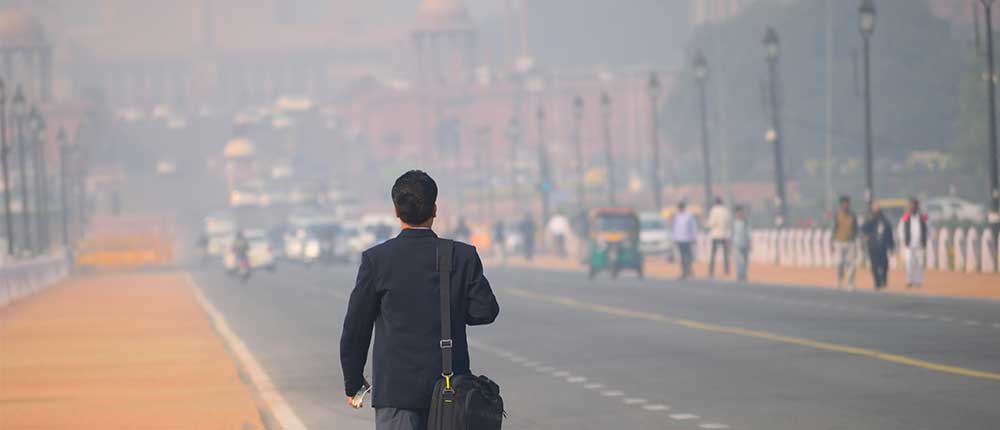It is time to take action on air pollution using both technology and awareness as major methods and it needs strong incentive mechanisms to ensure participation both by farmers and clean-energy producers

The concentrations of PM2.5 shoots 2 to 3 times (from 81-106 µg/m3 to 193 -270 µg/m3) in the villages of Punjab in November every year (during crop harvesting time) because large amounts of paddy straw are burnt. Nearly two to three times rise in pollution levels are noted both in the farms and in NCR. Interestingly, the concentrations are nearly the same in villages with interventions and without interventions, as the farms adopting interventions are few and closely clustered with stubble burning farms. So, exposure concentrations do not drop significantly, in other words, interventions need to be adopted by large number of farmers and not piecemeal.
More respiratory complaints (cough, phlegm, sneezing) are seen in the population, and more number of people complain. A nearly threefold increase is seen in number of older people with complains during high concentrations.
Further, a significant drop (roughly 10%) in lung function is seen in children during crop residue burning period. Based on studies in villages in Punjab, with large sample size >3600, analysis include several confounders age, gender, cooking fuel, ventilation, distance from road and agricultural field.)
Also, a notable increase in clinic visits (~11%) for respiratory illness is noted in Delhi, when PM increases beyond 200 µg/m3, which happen nearly every other day in NCR. Based on time series study of 2y, 85 clinics in Delhi, tracking and analyzing trends of nearly 5 lakh clinic visits, air pollution and meteorology data.
Such adverse health outcomes are also commonly seen in people exposed to poor air quality in homes using traditional cook stoves, and workers exposed to high vehicular traffic.
Other research
Recent estimates reported in Lancet, state that over a million {1·67 million (95% uncertainty interval 1·42–1·92)} deaths could be attributed to air pollution in India in 2019 in the country. Most of these deaths attributed to air pollution are from COPD (Chronic Obstructive Pulmonary Disease) (30%), lower respiratory illnesses (LRI) (24%), Ischemic heart disease/ heart attacks (20%).
Emerging challenges
The surge of air pollution can now be tracked. However, a silent surge of non-communicable diseases is happening, that makes the situation even more worrisome.
According to the recently (Jan, 2021) published LASI study – the Longitudinal Ageing Study in India, (a survey initiated in 2017-18 of population aged 45y and above) shows Kerala, Chandigarh, J&K have nearly twice (43%) the prevalence of self-reported cardio vascular diseases as opposed to the average for India (27%).
Self-reported prevalence of diabetes mellitus also shows Kerala (27%), Lakshadweep (22.8%), Puducherry (22%), have twice the (11.5%) prevalence of India. This increases the number of people sensitivity or vulnerable to falling sick because of air pollution in these states.
So, would this lead to larger number of population at-risk of showing up at the clinics on high air pollution days, and perhaps at pollution concentrations which are less hazardous?
Does it mean, the need for action against air pollution across the country is even more urgent?
This battle can be won
One effective way of reducing exposure in the Indo-Gangetic Plains would be generating Power or bio-CNG from stubble, instead of letting paddy straw be lit-up in the farms in 2021.
Essential for this to succeed is establishing supply chains - building stubble collection centers, safe storage and transport of stubble to processing units. However, this needs much more than harvesters and balers, storage, or processing. It needs strong incentive mechanisms to ensure participation both by farmers and clean-energy producers.
Environment thought leader Dr Ajay Mathur, TERI chief emphasizes it is time to take action on air pollution using both technology and awareness as major methods.
In a recently organized webinar by TERI, practionaires and academicians note the various extent of the effects on human health. Dr Anant Mohan, leading Pulmonologist at AIIMS observes, effect of air pollution on health depends on duration and degree of severity of exposure; recurrence, background immunity and medical conditions of the individual. Dr Dinesh Sethi, radiologist notes Artificial intelligence is the future for accurate monitoring, processing and prediction of air pollution effects on health to take actions for prevention and treatment. Dr Uma Kanga, an immunologist, summarizes the extent air pollution affects health of all ages starting from prenatal to adults to old age. The pollutants act as carriers for various infectious pathogens.
Dr Aakash Srivastava from NCDC shares that the Government of India (GoI) is working towards awareness generation through IEC campaigns and workshops along with development of surveillance systems for tracking health effects related to air pollution.
